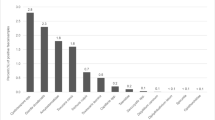Summary
Due to the large number of differential diagnostic possibilities, the etiology of endogenous uveitis is still hard to determine. One reason for uveitis may be the occurrence of parasites. However, too little attention is paid to this underlying disease.
Methods: To identify certain sources of infection, ovoscopic probes of 98 dog feces from the urban area of Halle were taken. The material was collected from children's playgrounds, parks and swimming pools. A retrospective analysis of patient case data from the records of the University Eye Hospital for the years 1986–1995 complemented the environmental and parasitological examination of patients with Toxocara canis and T. cati infections.
Results: From the ovoscopic examinations, 16 % of the fecal samples contained T. canis eggs. Seventeen percent contained coccicidal sporocysts. Eggs of Trichuris vulpis and not clearly identifiable nematodal larvae were found in 1 % of the samples. The reasons for the morphology was, in one instance, suspected Echinococcus eggs. The fact that 12 or 15 parasitologically positive dog excrement samples were taken from the immediate vicinity of children's playgrounds and another three directly from these grounds should be regarded as particularly critical. The investigated patient case data records revealed for the period studied nine uveitic patients with T. canis infection. The diagnosis was based on the larva precipitation test in all cases. After correct diagnosis and appropriate treatment, the prognosis was favorable. The specific treatment had to be repeated in two patients.
Conclusions: The environmental parasitological study presented proves the relatively high prevalence of pathogenic causal agents in dog excrement samples from the area of urban recreation and leisure grounds, in particular, children's playgrounds. Parasite infestation is a mirror of the efficiency of hygienic and social measures. Public health education must be reinforced. Differential diagnosis of chronic endogenous eye diseases must pay more attention to infections by parasites.
Zusammenfassung
Hintergrund: Die Klärung der Ätiologie endogener Uveitiden bereitet wegen der umfangreichen differentialdiagnostischen Möglichkeiten nach wie vor Schwierigkeiten. Ein Teilaspekt, dem aber nur bedingt Beachtung entgegengebracht wird, ist die Suche nach Parasiten.
Patienten und Methode: Um eine Aussage über mögliche Infektionsquellen treffen zu können, wurden ovoskopische Untersuchungen an 98 Hundekotproben aus dem Stadtgebiet von Halle durchgeführt. Die Materialentnahme erfolgte an Kinderspielplätzen, Park- und Badeanlagen. Eine retrospektive Analyse der Krankenblattdokumentationen der Universitäts-Augenklinik im Zehnjahreszeitraum 1986 bis 1995 von Patienten mit Toxocara canis-Infektionen ergänzte die umweltparasitologischen Untersuchungen.
Ergebnisse: Die mikroskopisch-helminthologischen Untersuchungen belegten für 16 % der Kotproben Toxocara canis-Eier. 17 % enthielten Kokzidien-Sporozysten, der Nachweis von Trichuris vulpis-Eiern sowie von nicht näher identifizierbaren Nematodenlarven gelang in jeweils 2 %. Auf Grund der Morphologie bestand in einem Fall der Verdacht auf Echinococcus-Eier. Unter hygienischem Gesichtspunkt besonders kritisch zu bewerten ist, daß 12 von 15 parasitologisch positiven Hundekotproben aus der unmittelbaren Umgebung der Spielplätze und 3 weitere direkt von diesen stammten. Die Auswertung der Krankenblattdokumentationen betraf für das geprüfte Untersuchungsintervall 9 Uveitis-Patienten mit einer Toxocara canis et cati-Infektion. In allen Fällen wurde die Diagnose mit dem Larvenpräzipitations- oder einem ELISA-Test gesichert. Die Erkrankungen verliefen nach richtiger Diagnosestellung und entsprechender Therapie prognostisch günstig. Bei 2 Patienten mußte die spezifische Behandlung allerdings wiederholt werden.
Schlußfolgerung: Die vorgelegte umweltparasitologische Studie belegt eine relativ hohe Prävalenz pathogener Erreger in Hundekotproben aus dem städtischen Erholungs- und Freizeitbereich mit besonderer Gefährdung der Kinderspielplätze. Der Parasitenbefall reflektiert die Effizienz hygienischer und sozialer Maßnahmen. Er belegt aber auch die Notwendigkeit der allgemeinen gesundheitspolitischen Aufklärung der Bevölkerung. Für die Prognose der Toxocara canis-Infektion ist das rechtzeitige Einbeziehen der Parasitose in die Differentialdiagnose entscheidend.
Similar content being viewed by others
Author information
Authors and Affiliations
Rights and permissions
About this article
Cite this article
Tost, F., Hellmann, A. & Ockert, G. Epidemiology of toxocariasis – environmental investigations. Ophthalmologe 95, 486–489 (1998). https://doi.org/10.1007/s003470050302
Published:
Issue Date:
DOI: https://doi.org/10.1007/s003470050302




